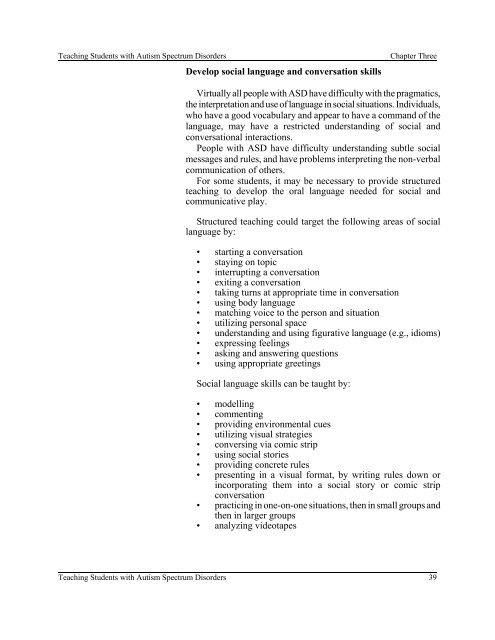Teaching Students with Autism Spectrum Disorders
Teaching Students with Autism Spectrum Disorders
Teaching Students with Autism Spectrum Disorders
Create successful ePaper yourself
Turn your PDF publications into a flip-book with our unique Google optimized e-Paper software.
<strong>Teaching</strong> <strong>Students</strong> <strong>with</strong> <strong>Autism</strong> <strong>Spectrum</strong> <strong>Disorders</strong> Chapter Three<br />
Develop social language and conversation skills<br />
Virtually all people <strong>with</strong> ASD have difficulty <strong>with</strong> the pragmatics,<br />
the interpretation and use of language in social situations. Individuals,<br />
who have a good vocabulary and appear to have a command of the<br />
language, may have a restricted understanding of social and<br />
conversational interactions.<br />
People <strong>with</strong> ASD have difficulty understanding subtle social<br />
messages and rules, and have problems interpreting the non-verbal<br />
communication of others.<br />
For some students, it may be necessary to provide structured<br />
teaching to develop the oral language needed for social and<br />
communicative play.<br />
Structured teaching could target the following areas of social<br />
language by:<br />
• starting a conversation<br />
• staying on topic<br />
• interrupting a conversation<br />
• exiting a conversation<br />
• taking turns at appropriate time in conversation<br />
• using body language<br />
• matching voice to the person and situation<br />
• utilizing personal space<br />
• understanding and using figurative language (e.g., idioms)<br />
• expressing feelings<br />
• asking and answering questions<br />
• using appropriate greetings<br />
Social language skills can be taught by:<br />
• modelling<br />
• commenting<br />
• providing environmental cues<br />
• utilizing visual strategies<br />
• conversing via comic strip<br />
• using social stories<br />
• providing concrete rules<br />
• presenting in a visual format, by writing rules down or<br />
incorporating them into a social story or comic strip<br />
conversation<br />
• practicing in one-on-one situations, then in small groups and<br />
then in larger groups<br />
• analyzing videotapes<br />
<strong>Teaching</strong> <strong>Students</strong> <strong>with</strong> <strong>Autism</strong> <strong>Spectrum</strong> <strong>Disorders</strong> 39

















